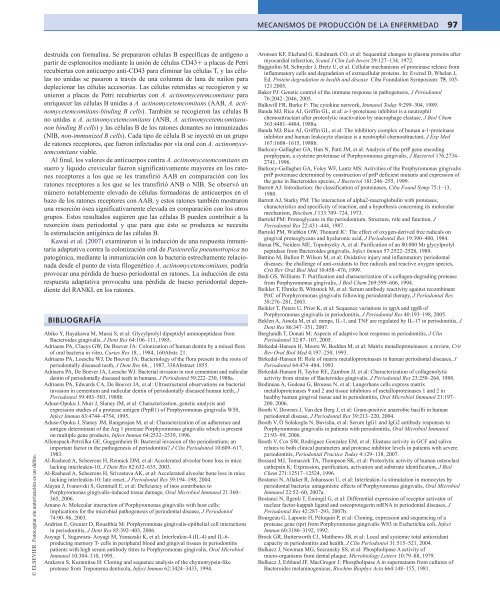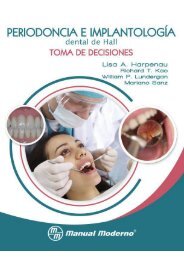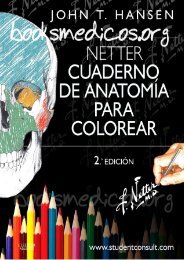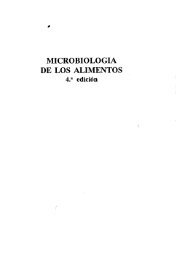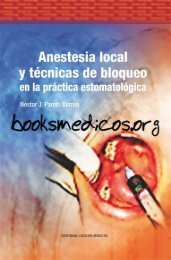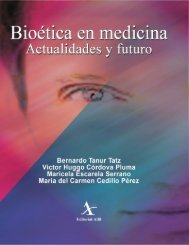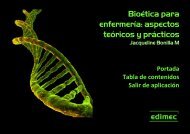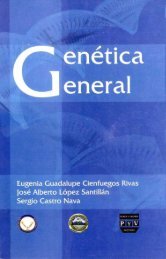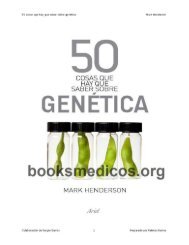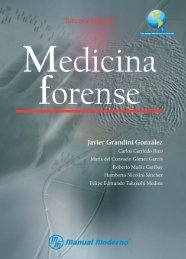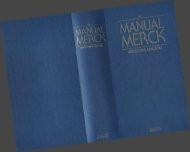Periodoncia.Eley.6a.Ed
You also want an ePaper? Increase the reach of your titles
YUMPU automatically turns print PDFs into web optimized ePapers that Google loves.
Mecanismos de producción de la enfermedad 97<br />
© ELSEVIER. Fotocopiar sin autorización es un delito.<br />
destruida con formalina. Se prepararon células B específicas de antígeno a<br />
partir de esplenocitos mediante la unión de células CD43+ a placas de Petri<br />
recubiertas con anticuerpo anti-CD43 para eliminar las células T, y las células<br />
no unidas se pasaron a través de una columna de lana de nailon para<br />
deplecionar las células accesorias. Las células retenidas se recogieron y se<br />
unieron a placas de Petri recubiertas con A. actinomycetemcomitans para<br />
enriquecer las células B unidas a A. actinomycetemcomitans (AAB, A. actinomycetemcomitans-binding<br />
B cells). También se recogieron las células B<br />
no unidas a A. actinomycetemcomitans (ANB, A. actinomycetemcomitansnon<br />
binding B cells) y las células B de los ratones donantes no inmunizados<br />
(NIB, non-immunized B cells). Cada tipo de célula B se inyectó en un grupo<br />
de ratones receptores, que fueron infectadas por vía oral con A. actinomycetemcomitans<br />
viable.<br />
Al final, los valores de anticuerpos contra A. actinomycetemcomitans en<br />
suero y líquido crevicular fueron significativamente mayores en los ratones<br />
receptores a los que se les transfirió AAB en comparación con los<br />
ratones receptores a los que se les transfirió ANB o NIB. Se observó un<br />
número notablemente elevado de células formadoras de anticuerpos en el<br />
bazo de los ratones receptores con AAB, y estos ratones también mostraron<br />
una resorción ósea significativamente elevada en comparación con los otros<br />
grupos. Estos resultados sugieren que las células B pueden contribuir a la<br />
resorción ósea periodontal y que para que ésto se produzca se necesita<br />
la estimulación antigénica de las células B.<br />
Kawai et al. (2007) examinaron si la inducción de una respuesta inmunitaria<br />
adaptativa contra la colonización oral de Pasteurella pneumotropica no<br />
patogénica, mediante la inmunización con la bacteria estrechamente relacionada<br />
desde el punto de vista filogenético A. actinomycetemcomitans, podría<br />
provocar una pérdida de hueso periodontal en ratones. La inducción de esta<br />
respuesta adaptativa provocaba una pérdida de hueso periodontal dependiente<br />
del RANKL en los ratones.<br />
Bibliografía<br />
Abiko Y, Hayakawa M, Murai S, et al: Glycylprolyl dipeptidyl aminopeptidase from<br />
Bacteroides gingivalis, J Dent Res 64:106–111, 1985.<br />
Adriaens PA, Claeys GW, De Boever JA: Colonization of human dentin by a mixed flora<br />
of oral bacteria in vitro, Caries Res 18, , 1984, 160Abstr. 21.<br />
Adriaens PA, Loesche WJ, De Boever JA: Bacteriology of the flora present in the roots of<br />
periodontally diseased teeth, J Dent Res 66, , 1987, 338Abstract 1855.<br />
Adriaens PA, De Boever JA, Loesche WJ: Bacterial invasion in root cementum and radicular<br />
dentin of periodontally diseased teeth in humans, J Periodontol 59:222–230, 1988a.<br />
Adriaens PA, <strong>Ed</strong>wards CA, De Boever JA, et al: Ultrastructural observations on bacterial<br />
invasion in cementum and radicular dentin of periodontally diseased human teeth, J<br />
Periodontol 59:493–503, 1988b.<br />
Aduse-Opoku J, Muir J, Slaney JM, et al: Characterization, genetic analysis and<br />
expression studies of a protease antigen (PrpR1) of Porphyromonas gingivalis W50,<br />
Infect Immun 63:4744–4754, 1995.<br />
Aduse-Opoku J, Slaney JM, Rangarajan M, et al: Characterization of an adherence and<br />
antigen determinant of the Arg 1 protease Porphyromonas gingivalis which is present<br />
on multiple gene products, Infect Immun 64:2532–2539, 1996.<br />
Allenspach-Petrzilka GE, Guggenheim B: Bacterial invasion of the periodontium; an<br />
important factor in the pathogenesis of periodontitis? J Clin Periodontol 10:609–617,<br />
1983.<br />
Al-Rasheed A, Scheerens H, Rennick DM, et al: Accelerated alveolar bone loss in mice<br />
lacking interleukin-10, J Dent Res 82:632–635, 2003.<br />
Al-Rasheed A, Scheerens H, Srivastava AK, et al: Accelerated alveolar bone loss in mice<br />
lacking interleukin-10: late onset, J Periodontal Res 39:194–198, 2004.<br />
Alayan J, Ivanovski S, Gemmell E, et al: Deficiency of inos contributes to<br />
Porphyromonas gingivalis-induced tissue damage, Oral Microbiol Immunol 21:360–<br />
365, 2006.<br />
Amano A: Molecular interaction of Porphyromonas gingivalis with host cells:<br />
implications for the microbial pathogenesis of periodontal disease, J Periodontol<br />
74:90–96, 2003.<br />
Andrian E, Grenier D, Rouabhia M: Porphyromonas gingivalis-epithelial cell interactions<br />
in periodontitis, J Dent Res 85:392–403, 2006.<br />
Aoyagi T, Sugawara- Aoyagi M, Yamazaki K, et al: Interleukin-4 (IL-4) and IL-6-<br />
producing memory T- cells in peripheral blood and gingival tissues in periodontitis<br />
patients with high serum antibody titres to Porphyromonas gingivalis, Oral Microbiol<br />
Immunol 10:304–310, 1995.<br />
Arakawa S, Kuramitsu H: Cloning and sequence analysis of the chymotrypsin-like<br />
protease from Treponema denticola, Infect Immun 62:3424–3433, 1994.<br />
Aronsen KF, Ekelund G, Kindmark CO, et al: Sequential changes in plasma proteins after<br />
myocardial infarction, Scand J Clin Lab Invest 29:127–134, 1972.<br />
Baggiolini M, Schnyder J, Bretz U, et al. Cellular mechanisms of proteinase release from<br />
inflammatory cells and degradation of extracellular proteins. In: Evered D, Whelan J,<br />
<strong>Ed</strong>. Protein degradation in health and disease Ciba Foundation Symposium: 75, 105-<br />
121.2005,<br />
Baker PJ: Genetic control of the immune response in pathogenesis, J Periodontol<br />
76:2042–2046, 2005.<br />
Balkwill FR, Burke F: The cytokine network, Immunol Today 9:299–304, 1989.<br />
Banda MJ, Rice AJ, Griffin GL, et al: a-1-proteinase inhibitor is a neutrophil<br />
chemoattractant after proteolytic inactivation by macrophage elastase, J Biol Chem<br />
363:4481–4484, 1988a.<br />
Banda MJ, Rice AJ, Griffin GL, et al: The inhibitory complex of human a-1-proteinase<br />
inhibitor and human leukocyte elastase is a neutrophil chemoattractant, J Exp Med<br />
167:1608–1615, 1988b.<br />
Barkocy-Gallagher GA, Han N, Patti JM, et al: Analysis of the prtP gene encoding<br />
porphypain, a cysteine proteinase of Porphyromonas gingivalis, J Bacteriol 176:2734–<br />
2741, 1996.<br />
Barkocy-Gallagher GA, Foley WF, Lantz MS: Activities of the Porphyromonas gingivalis<br />
prtP proteinase determined by construction of prtP deficient mutants and expression of<br />
the gene in Bacteroides species, J Bacteriol 181:246–255, 1999.<br />
Barrett AJ: Introduction: the classification of proteinases, Ciba Found Symp 75:1–13,<br />
1980.<br />
Barrett AJ, Starky PM: The interaction of alpha2-macroglobulin with proteases,<br />
characteristics and specificity of reaction, and a hypothesis concerning its molecular<br />
mechanism, Biochem J 133:709–724, 1973.<br />
Bartold PM: Proteoglycans in the periodontium. Structure, role and function, J<br />
Periodontal Res 22:431–444, 1987.<br />
Bartold PM, Wiebkin OW, Thonard JC: The effect of oxygen-derived free radicals on<br />
gingival proteoglycans and hyaluronic acid, J Periodontal Res 19:390–400, 1984.<br />
Barua PK, Neiders ME, Topolnyeky A, et al: Purification of an 80:000 Mr glycylprolyl<br />
peptidase from Bacteroides gingivalis, Infect Immun 57:2522–2528, 1989.<br />
Battino M, Bullon P, Wilson M, et al: Oxidative injury and inflammatory periodontal<br />
diseases: the challenge of anti-oxidants to free radicals and reactive oxygen species,<br />
Crit Rev Oral Biol Med 10:458–476, 1999.<br />
Bedi GS, Williams T: Purification and characterization of a collagen-degrading protease<br />
from Porphyromonas gingivalis, J Biol Chem 269:599–606, 1994.<br />
Beikler T, Ehmke B, Wittstock M, et al: Serum antibody reactivity against recombinant<br />
PrtC of Porphyromonas gingivalis following periodontal therapy, J Periodontal Res<br />
38:276–281, 2003.<br />
Beikler T, Peters U, Prior K, et al: Sequence variations in rgpA and rgpB of<br />
Porphyromonas gingivalis in periodontitis, J Periodontal Res 40:193–198, 2005.<br />
Beklen A, Ainola M, et al: mmps, IL-1, and TNF are regulated by IL-17 in periodontitis, J<br />
Dent Res 86:347–351, 2007.<br />
Berglundh T, Donati M: Aspects of adaptive host response in periodontitis, J Clin<br />
Periodontol 32:87–107, 2005.<br />
Birkedal-Hansen H, Moore W, Bodden M, et al: Matrix metalloproteinases: a review, Crit<br />
Rev Oral Biol Med 4:197–250, 1993.<br />
Birkedal-Hansen H: Role of matrix metalloproteinases in human periodontal diseases, J<br />
Periodontol 64:474–484, 1993.<br />
Birkedal-Hansen H, Taylor RE, Zambon JJ, et al: Characterization of collagenolytic<br />
activity from strains of Bacteroides gingivalis, J Periodontal Res 23:258–264, 1988.<br />
Bodineau A, Godeau G, Brousse N, et al: Langerhans cells express matrix<br />
metalloproteinases 9 and 2 and tissue inhibitors of metalloproteinases 1 and 2 in<br />
healthy human gingival tissue and in periodontitis, Oral Microbiol Immunol 21:197–<br />
200, 2006.<br />
Booth V, Downes J, Van den Berg J, et al: Gram-positive anaerobic bacilli in human<br />
periodontal disease, J Periodontal Res 39:213–220, 2004.<br />
Booth V, Ö Solakoglu N, Bavisha, et al: Serum IgG1 and IgG2 antibody responses to<br />
Porphyromonas gingivalis in patients with periodontitis, Oral Microbiol Immunol<br />
21:93–99, 2006.<br />
Booth V, Cox SW, Rodriguez Gonzalez EM, et al: Elastase activity in GCF and saliva<br />
relates to both clinical parameters and protease inhibitor levels in patients with severe<br />
periodontitis, Periodontal Practice Today 4:129–138, 2007.<br />
Bossard MJ, Tomaszek TA, Thompson SK, et al: Proteolytic activity of human osteoclast<br />
cathepsin K: Expression, purification, activation and substrate identification, J Biol<br />
Chem 271:12517–12524, 1996.<br />
Bostanci N, Allaker R, Johansson U, et al: Interleukin-1a stimulation in monocytes by<br />
periodontal bacteria: antagonistic effects of Porphyromonas gingivalis, Oral Microbiol<br />
Immunol 22:52–60, 2007a.<br />
Bostanci N, Ilgenli T, Emingil G, et al: Differential expression of receptor activator of<br />
nuclear factor-kappab ligand and osteoprotegerin mRNA in periodontal diseases, J<br />
Periodontal Res 42:287–293, 2007b.<br />
Bourgeau G, Laponte H, Péloquin P, et al: Cloning, expression and sequencing of a<br />
protease gene (tpr) from Porphyromonas gingivalis W83 in Escherichia coli, Infect<br />
Immun 60:3186–3192, 1992.<br />
Brock GR, Butterworth CJ, Matthews JB, et al: Local and systemic total antioxidant<br />
capacity in periodontitis and health, J Clin Periodontol 31:515–521, 2004.<br />
Bulkacz J, Newman MG, Socransky SS, et al: Phospholipase A activity of<br />
micro-organisms from dental plaque, Microbiology Letters 10:79–88, 1979.<br />
Bulkacz J, Erbland JF, MacGregor J: Phospholipase A in supernatants from cultures of<br />
Bacteroides melaninogenicus, Biochim Biophys Acta 664:148–155, 1981.


